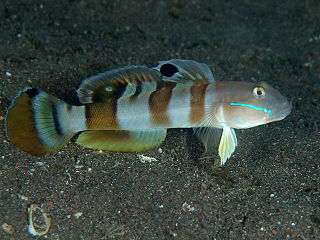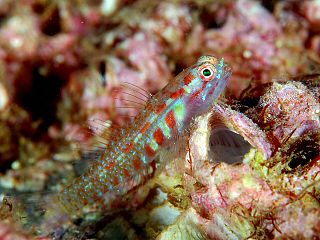Sex change is a process by which a living being changes sex – that is, by which female sexual characteristics are substituted for male ones or vice versa.

Gobiidae is a family of bony fish in the order Gobiiformes, one of the largest fish families comprising more than 2,000 species in more than 200 genera, sometimes referred to as the "true gobies". Most of them are relatively small, typically less than 10 cm (3.9 in) in length. The Gobiidae includes some of the smallest vertebrates in the world, such as Trimmatom nanus and Pandaka pygmaea, Trimmatom nanus are under 1 cm long when fully grown, then Pandaka pygmaea standard length are 9mm (0.35 in),maximum known standard length are 11 mm (0.43 in). Some large gobies can reach over 30 cm (0.98 ft) in length, but that is exceptional. Generally, they are benthic, or bottom-dwellers. Although few are important as food for humans, they are of great significance as prey species for commercially important fish such as cod, haddock, sea bass, and flatfish. Several gobiids are also of interest as aquarium fish, such as the dartfish of the genus Ptereleotris. Phylogenetic relationships of gobiids have been studied using molecular data.

Thalassoma bifasciatum, the bluehead, bluehead wrasse or blue-headed wrasse, is a species of marine ray-finned fish, a wrasse from the family Labridae. It is native to the coral reefs of the tropical waters of the western Atlantic Ocean. Individuals are small and rarely live longer than two years. They form large schools over the reef and are important cleaner fish in the reefs they inhabit.

Gobiodon is a genus of gobies also known as coral gobies or "clown gobies". Generally, coral gobies, unlike the rest of the family Gobiidae, are not burrowers, but instead prefer to inhabit the branches of certain Acropora or similar hard corals.

Exyrias akihito is a species of marine goby. Since the recent description of this species it has been found to have a wide distribution in the western Pacific including the Great Barrier Reef, New Guinea, Indonesia, the Philippines and the Yaeyama Islands, Japan. One individual was photographed in Palau, and on January 13, 2005 one was caught in the lagoon of Majuro Atoll in the Marshall Islands. This animal had only 9 soft rays in its dorsal fin instead of the normal 10, a congenital abnormality known to occasionally occur in gobies and other fish.

Valenciennea is a genus of small, bottom-dwelling fish in the family Gobiidae. They are found over sandy bottoms, often at coral reefs in the Indo-Pacific. The members of the genus tend to rest directly on the substrate for extended periods of time. While this is a common behavior for members of the family, this genus also float motionless directly above the substrate, which is why they are sometimes called glider gobies. Their resting behavior has resulted in the vernacular name "sleeper gobies", which invites confusion with the related family Eleotridae. The members of this genus are known to be carnivorous sand-sifters; to eat, they simply engulf entire mouthfuls of sand which they expel through their gills. Specialized structures in their gills filter small crustaceans and worms as the sand is expelled. It is this specific trait that makes some members of the genus attractive to the marine aquarist, and they are often introduced into a marine aquarium for sand-sifting. Some of the species are known to be monogamous. The genus was named after notable French zoologist Achille Valenciennes. These fish are difficult to keep in a tank. Tanks with plenty of live sand and live rock are recommended. Offer foods such as sinking shrimp pellets. Fish may die even if eating properly.

Eviota is a genus of fish in the family Gobiidae, commonly as dwarfgobies found in the Indo-Pacific region, where it is distributed from Japan to Australia and from Africa to Pitcairn Island. Species are mainly associated with coral reefs. Many of these fish are short-lived, with life cycles as brief as 3.5 weeks in the tropics. Some species are hermaphrodites and some representatives live symbiotically among the tentacles of the mushroom coral.
Eviota readerae is a species of goby associated with reefs and tide pools. It has a very limited distribution in the southwest Pacific, being found only on the Elizabeth and Middleton Reefs and the Lord Howe Rise in the Tasman Sea.

Elacatinus is a genus of small marine gobies, often known collectively as the neon gobies. Although only one species, E. oceanops, is technically the "neon goby," because of their similar appearance, other members of the genus are generally labeled neon gobies, as well. Except for a single East Pacific species, all reside in warmer parts of the West Atlantic, including the Caribbean and Gulf of Mexico. They are known for engaging in symbiosis with other marine creatures by providing them cleaning service that consists of getting rid of ectoparasites on their bodies. In return, Elacatinus species obtain their primary source of food, ectoparasites.

Pseudanthias huchtii, the red cheek fairy basslet, threadfin anthias or Pacific basslet is a species of marine ray-finned fish, a member of the genus Pseudanthias which is part of the subfamily Anthiinae, which in turn is part of the family Serranidae, the groupers and sea basses. It comes from the Western Central Pacific Ocean. It occasionally makes its way into the aquarium trade. It grows to a size of 12 cm in length.

Gobiodon histrio, the Broad-barred goby, is a species of goby native to the Indian Ocean from the Red Sea to the western Pacific Ocean to southern Japan, Samoa and the Great Barrier Reef. This species is a reef dweller, being found at depths of from 2 to 15 metres. It can reach a length of 3.5 centimetres (1.4 in) TL. This species can also be found in the aquarium trade.

True gobies were a subfamily, the Gobiinae, of the goby family Gobiidae, although the 5th edition of the Fishes of the World does not subdivide the Gobiidae into subfamilies. They are found in all oceans and a few rivers and lakes, but most live in warm waters. Altogether, the Gobiinae unite about 1149 described species in 160 genera, and new ones are still being discovered in numbers.

Rhinogobiops nicholsii, the blackeye goby, is a species of true goby in the family Gobiidae. It is the sole species classified under the genus Rhinogobiops. They are common inhabitants of coral reefs and rocky habitats along the Eastern Pacific Ocean coasts of Mexico, the United States, and Canada, although they are hardly noticed, as they often rest motionless near their shelters. Other common names for the species include bluespot goby and crested goby.

The largetooth goby, also known as Wilbur's goby, is a species of ray-finned fish from the family Gobiidae which is native to the Indo-Pacific from the Seychelles to Micronesia. Its known range has been extended to the Red Sea as specimens were photographed at one site and collected at another site off Egypt. This species lives in sheltered marine waters at depths of from 0 to 20 metres preferring areas with sandy substrates. This species grows to a length of 6.5 centimetres (2.6 in) SL. This species is the only known member of its genus. This species is not obviously sexually dimorphic and it has a background colour of pale brown to greenish-brown and a pale ventral side. The body is marked with brown and white spots, pairs of larger brown spots create a mid-lateral row along its flanks and there is a dark spot on the caudal fin peduncle. It has a brown blotch on the cheek and a series of short brown bars along its back. The largetooth goby is a solitary fish which is found in coastal bays, lagoons and estuaries over fine sandy substrates close to the margins of reefs or silt beds in the vicinity of sheltered and often turbid coastal reefs. It is most frequently collected from shallow waters to 7 metres (23 ft), around coral reefs but off southern Japan, the largetooth goby occurs at the bottom of sandy bays. The specific name honours the American physician, Ray Lyman Wilbur (1875–1949) who was president of Stanford University from 1916–1943, as well as being the United States Secretary of the Interior from 1929–1933. Wilbur helped the author, Herre, get to Palau, the type locality of this species.
Paedogobius kimurai is a species of goby from the subfamily Gobionellinae, and the only member of the monotypic genus Paedogobius. It is native to marine and brackish waters of inner bays in Japan, Thailand and Australia. Its English language common names include wide-gape paedomorphic goby and babyface goby. Its Japanese language common name is shirasukiba-haze.
Sueviota is a genus of fish in the family Gobiidae native to the Indian and Pacific Ocean.

Trimma is a genus of fish in the family Gobiidae native to the Indian and Pacific Ocean. Together with members of the genus Eviota, they are known commonly as pygmygobies or dwarfgobies.

Trimma nasa, commonly called the nasal dwarfgoby or nasal pygmy goby, is a species of goby from the Western Pacific. They are small fish, averaging at around 2 cm (0.79 in) in length. They are bright orange and transparent yellow in life, with a white stripe running down from between the eyes to the upper lip and a dark brown spot at the base of the tail fin. They are usually found in large schools in the sloping or vertical drop-offs at coral reef edges.
Trimma tevegae, commonly known as the bluestripe pygmygoby or blue-striped cave goby among other names, is a species of goby from the western Pacific. They are small fish, averaging at 2 cm (0.79 in), orange-brown with white undersides in life, with characteristic iridescent blue or lavender stripes on the sides and on top of the body. They are usually found in large schools in the sloping or vertical drop-offs at coral reef edges. They are sometimes caught for the aquarium trade, and are also known by hobbyists under the name blue line flagtail goby. The species is named in honor of the schooner Te Vega.
Pseudogobiopsis lumbantobing is a species of goby from the subfamily Gobionellinae which is found in Java and Sumatra where it occurs in freshwater rivers and streams at altitudes of 5–22 metres (16–72 ft), with substrates made up of sand, gravel, rock and boulders and where there may be growths of algae and aquatic macrophytes. This species had been traded in the European aquarium trade since 2001. The specific name honours the ichthyologist Daniel Lumbantobing of the Florida Museum of Natural History who showed the first specimens which he had collected to Helen K. Larson in 2012, this resolved the identity of the orange-spotted gobies which had been recorded in the European aquarium trade and which aquarists had sent pictures to Larson for identification.














